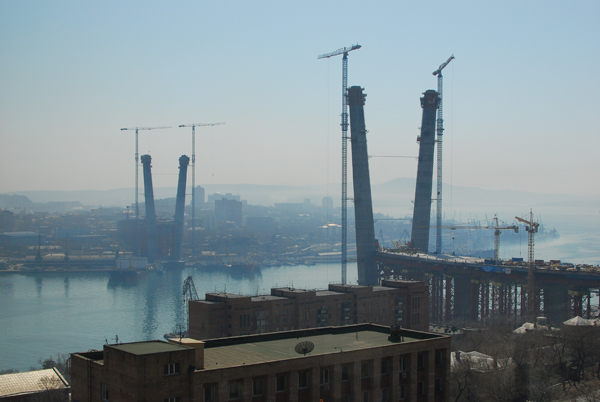Moscow is looking to Russia’s Far East as a region poised for better times, and a building boom aims to make Vladivostok an investment hub. But young residents are still leaving the city in droves.

VLADIVOSTOK, Russia—Mikhail Gorbachev once said that Russia’s Far East had a “glorious future,” describing it as a “land of colossal natural riches, huge social and economic potential, and a great international prospect.”
A quarter century after Mr. Gorbachev boldly predicted prosperity for Vladivostok, a city 5,300 miles from Moscow and just a five-hour drive from China’s border, this once-booming Pacific Ocean port is a rusted Soviet relic with a falling population beset by corruption and neglect.
But Moscow is once again looking to its eastern reaches as a region poised for better times. In fact, much of Vladivostok has been turned into a construction site as it is busily being rebuilt to accommodate the September 2012 Asia-Pacific Economic Cooperation (APEC) conference. Moscow wants the prestigious summit to be something of a coming-out party for the region, hoping to promote foreign investment and stave off perceptions that it will one day be dominated by China.
The building boom is visible just about everywhere. Two pairs of concrete support pylons tower over the Eastern Bosphorus Strait, part of a cable-stayed bridge that will link the city to sparsely populated Russky Island, which will host the summit meetings. Highways are being chewed up and expanded and new hotels built. Another bridge reaches out across the Golden Horn Bay, dwarfing Vladivostok’s imperial city center.
In Soviet times, Vladivostok – home of the Pacific Fleet – was a closed city run by the military, propped up by federal subsidies. When communism fell, subsidies ended, along with the military industries that had provided much of the region’s jobs. Since 1991, Vladivostok’s population has fallen from 648,000 to around 578,000, while the population of the Far East Federal District – a territory four-fifths the size of Australia – has dropped from 8 million to just over 6 million.
“This is why the Russian government is putting huge amounts of money into the Far East and into Vladivostok,” says Alexandr Latkin, an economist at the Vladivostok State University of Economics and Service. “They want to bring back the status of the Far East that was lost during the 1990s.”
Will the new construction help the region? Many locals say the influx of cash ahead of the summit – 426 billion rubles (just over $15 billion), or 60 times Vladivostok’s annual budget – is doing little to bring jobs or other long-term benefits. Marina Rashchepkina, a second-year student at the Far Eastern Federal University, says young people in her hometown of Amursk, a pulp-industry town 500 miles north, are leaving in droves.
“They really don’t want to get back,” she says. “Most of the young people I know, if they have knowledge of a foreign language … they are very willing to leave.” Like many others, Ms. Rashchepkina was unsure how the APEC Summit might benefit locals. “September comes, the summit takes place, and then what?” she says. “We are all skeptical.”
Andrey Kalachinsky, a veteran Vladivostok journalist, described the APEC construction drive as “propaganda.” While tens of thousands of workers have been employed on the new projects, he says a large proportion of them are outsiders and that little benefit was reaching locals.
“It’s good propaganda for Moscow people…. For local people, we need other things: jobs, good salaries, and the possibility to buy a new house or own apartments,” he says. “The economy is good when you have more money than before. Now I really don’t know any real businessman here who can say that he has more money than before. All the money is going back to Moscow.”
David Satter, author of “Darkness at Dawn: The Rise of the Russian Criminal State”, says corruption in the Primorsky region around Vladivostok – which he called “the most criminalized enclave in the whole country” during the 1990s – is still repelling foreign investment.
“One of the reasons why the Vladivostok region has problems is that it’s a very undesirable climate for investment because it’s so criminal,” he says. “That’s not going to change as a result of what they’re doing.”
Many recognize that the key to the region’s future – and tapping the region’s vast mineral wealth – is closer ties with China. The region is already dependent on Asia-Pacific trade: 70 percent of its produce is imported from China and nearly all of its cars come from Japan. But despite a recent number of Asian mining and energy deals, obstacles to trade remain.
China’s rising influence – and growing population – next door have stoked fears that the region will be “lost” to the Chinese. That concern was vocalized by President Dmitry Medvedev in 2008 when he said the region’s loss could occur as unexpectedly as the fall of the Soviet Union. As a result, Chinese nationals face difficulty getting work visas, and in the early 2000s, regional authorities banned Chinese merchants from selling in local markets. Mr. Kalachinsky says such attitudes have to change if Vladivostok is going to truly prosper.
“Russia is not a very good place for Chinese people to work or live,” he says. “It’s not enough: We need to open our city.”
[Published in the Christian Science Monitor, September 20, 2011]


